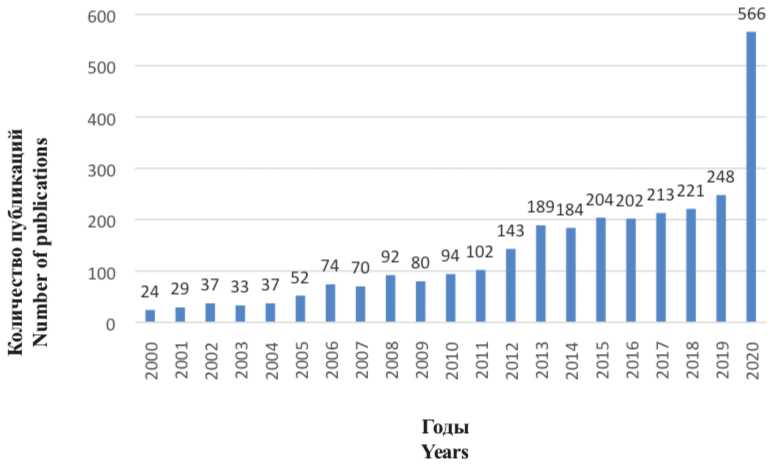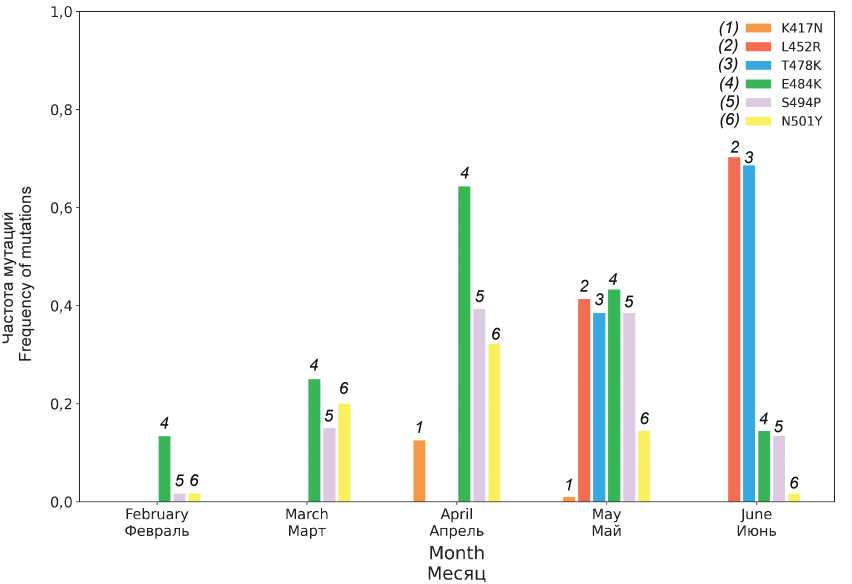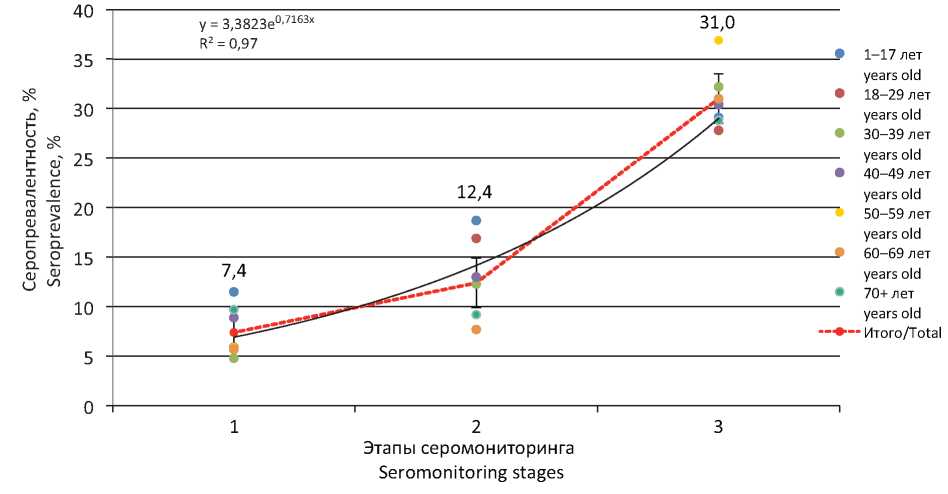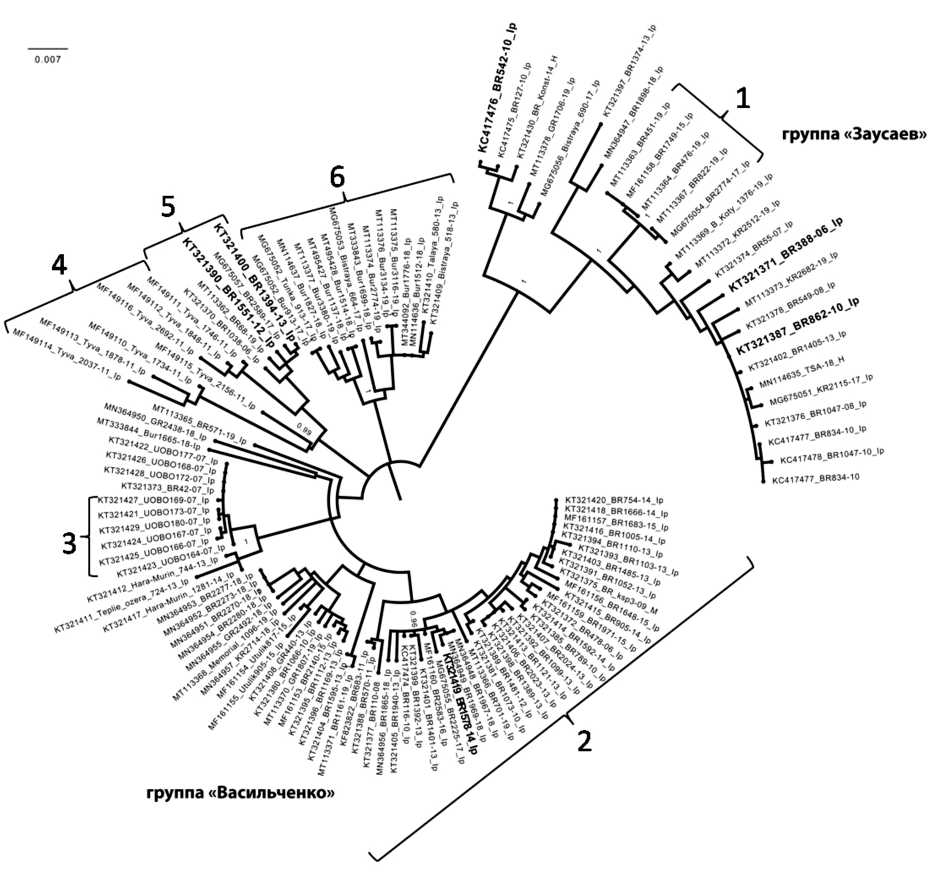Vol 66, No 4 (2021)
- Year: 2021
- Published: 18.09.2021
- Articles: 10
- URL: https://virusjour.crie.ru/jour/issue/view/51
Full Issue
REVIEWS
Potential of application of the RNA interference phenomenon in the treatment of new coronavirus infection COVID-19
Abstract
COVID-19 has killed more than 4 million people to date and is the most significant global health problem. The first recorded case of COVID-19 had been noted in Wuhan, China in December 2019, and already on March 11, 2020, World Health Organization declared a pandemic due to the rapid spread of this infection. In addition to the damage to the respiratory system, SARS-CoV-2 is capable of causing severe complications that can affect almost all organ systems. Due to the insufficient effectiveness of the COVID-19 therapy, there is an urgent need to develop effective specific medicines. Among the known approaches to the creation of antiviral drugs, a very promising direction is the development of drugs whose action is mediated by the mechanism of RNA interference (RNAi). A small interfering RNA (siRNA) molecule suppresses the expression of a target gene in this regulatory pathway. The phenomenon of RNAi makes it possible to quickly create a whole series of highly effective antiviral drugs, if the matrix RNA (mRNA) sequence of the target viral protein is known. This review examines the possibility of clinical application of siRNAs aimed at suppressing reproduction of the SARS-CoV-2, taking into account the experience of similar studies using SARS-CoV and MERS-CoV infection models. It is important to remember that the effectiveness of siRNA molecules targeting viral genes may decrease due to the formation of viral resistance. In this regard, the design of siRNAs targeting the cellular factors necessary for the reproduction of SARS-CoV-2 deserves special attention.
 241-251
241-251


Prospects for using low-dose radiation in the complex therapy for COVID-19
Abstract
This review presents the literature data of new approaches for the treatment of COVID-19 with low doses of radiation (LDR). In addition, data on the use of LDR for the treatment of various disorders, in particular pneumonia, a number of inflammatory processes of various etiology, as well as Alzheimer’s disease are discussed. The mechanisms of LDR action are briefly described, associated with the activation of the immune system and antiinflammatory response due to the effect on the processes of oxidative stress, which is reflected in an increase in the activity of cytokines (interleukin- (IL-) 6), changes in the expression of a number of genes (such as P53 and NF-κB (p65)) and long non-coding RNAs (ncRNAs) (the authors’ own data are presented). Based on the analysis of the material presented, it can be assumed that further clinical trials of the effect of MDR (5–10 cGy) on patients with COVID-19, who are at different stages of the disease, will reveal the optimal conditions for the development and use of an effective treatment regimen.
 252-258
252-258


Viruses and bats: interdisciplinary issues
Abstract
The virologists’ attention to bats (Сhiroptera) changed in the late 20th century as the concept of emerging infections grew in popularity. Since the beginning of the COVID-19 pandemic, the number of publications on bat viruses has increased profoundly.
History of the problem; biodiversity of Chiroptera and related viruses; medical and veterinary significance of some viral genera and subgenera (Lyssavirus, Henipavirus, Marburgvirus, Ebolavirus, Sarbecovirus, Merbecovirus), as well as problems of bat protection, are addressed in a concise form. Literature search was carried out in electronic databases, mainly for the period of 2000–2021. Publications in Russian that are poorly represented in English-language reviews are also included. The purpose of the review is to substantiate the importance of an interdisciplinary approach in the context of increased interest in the study of viral infections in bats. This review was written for researchers who have not previously dealt with this problem.
Since the beginning of this century, the number of known virus species associated with bats has increased by an order of magnitude (>200). The families Rhabdoviridae, Coronaviridae, Paramyxoviridae are in the first ranks according to the number of findings, and the highest diversity of viruses has been established for the families Vespertilionidae, Pteropodidae, Molossidae. Interdisciplinary cooperation positively influences the efficiency, biological safety and practical significance of the ongoing research. The best results were achieved by multidisciplinary teams with good cross-training in several specialties. Many papers emphasize the need to balance health and conservation interests.
The analysis of scientific publications indicates a change in research approaches in this area: from collecting individual facts within the framework of narrow specialties to a comprehensive assessment of new knowledge from ecological, evolutionary and socio-economic positions. Results of the research emphasize the need to maintain complex approaches addressing public health needs and environmental protection. The importance of bat-borne viral infections determines the necessity for correction and interdepartmental coordination of scientific research and surveillance of wildlife zoonoses in the Russian Federation.
 259-268
259-268


ORIGINAL RESEARCHES
Monitoring the spread of the SARS-CoV-2 (Coronaviridae: Coronavirinae: Betacoronavirus; Sarbecovirus) variants in the Moscow region using targeted high-throughput sequencing
Abstract
Introduction. Since the outbreak of the COVID-19 pandemic caused by SARS-CoV-2 novel coronavirus, the international community has been concerned about the emergence of mutations altering some biological properties of the pathogen like increasing its infectivity or virulence. Particularly, since the end of 2020, several variants of concern have been identified around the world, including Alpha (B.1.1.7), Beta (B.1.351), Gamma (P.1), and Delta (B.1.617.2). However, the existing mechanism of detecting important mutations are not always effective enough, since only a relatively small part of all pathogen samples can be examined by whole genome sequencing due to its high cost.
Material and methods. In this study, we have designed special primer panel and used it for targeted highthroughput sequencing of several significant S-gene (spike) regions of SARS-CoV-2. The Illumina platform averaged approximately 50,000 paired-end reads with a length of ≥150 bp per sample. This method was used to examine 579 random samples obtained from COVID-19 patients in Moscow and the Moscow region from February to June 2021.
Results. This study demonstrated the dynamics of distribution of several SARS-CoV-2 strains and its some single mutations. It was found that the Delta strain appeared in the region in May 2021, and became prevalent in June, partially displacing other strains.
Discussion. The obtained results provide an opportunity to assign the viral samples to one of the strains, including the previously mentioned in time- and cost-effective manner. The approach can be used for standardization of the procedure of searching for mutations in individual regions of the SARS-CoV-2 genome. It allows to get a more detailed data about the epidemiological situation in a region.
 269-278
269-278


Study of the specific toxic effects of the substance 1-[2-(2-benzoylphenoxy)ethyl]-6-methyluracil, the original non-nucleoside inhibitor of human immunodeficiency virus type 1 (Retroviridae; Orthoretrovirinae; Lentivirus: Human immunodeficiency virus 1) reverse transcriptase
Abstract
Introduction. Combination antiretroviral therapy is currently the main component of treatment for human immunodeficiency virus (HIV) infected patients. At the same time, the high mutational potential of the virus and the frequency of side effects of existing drugs dictate the need for the development and preclinical study of new, more effective and safer compounds.
The aim of the study is to evaluate the specific types of toxicity of a new non-nucleoside inhibitor of human immunodeficiency virus type 1 (HIV-1) reverse transcriptase (RNA-dependent DNA revertase) (NNRTI) based on the substance 1-[2-(2-benzoylphenoxy)ethyl]-6-methyluracil, a benzophenone derivative.
Material and methods. The study investigated reproductive toxicity, embryotoxicity, immunotoxicity, genotoxic (in micronucleus test in and comet assay) and allergenic properties of the test itemcompound. It was tested on three species of animals in two doses: the estimated therapeutic dose (1 TD) and its tenfold equivalent (10 TD). Taking into account the metabolic coefficients, the doses for rats (Rattus) were 9 and 90 mg/kg, for mice (Mus musculus), 21 and 210 mg/kg, and for guinea pigs (Cavia porcellus), 8 and 80 mg/kg, respectively.
Results and discussion. According to the obtained results, a favorable safety profile of the tested compound was established. Negative effects on the immune system, reproductive function, the body of pregnant animals and the fetus were not observed, as well as the compound did not have genotoxic and allergenic properties.
Conclusion. These data allows to consider the studied compound as a promising therapeutic candidate for the treatment of HIV-1 infection.
 279-288
279-288


Flow cytometry evaluation of the rhesus monkey cellular immunity following the Zaire ebolavirus (Filoviridae; Ebolavirus: Zaire ebolavirus) experimental infection
Abstract
Introduction. The outbreaks of the Zaire ebolavirus (ZE) disease (ZED) that have arisen in the last decade determine the need to study the infection pathogenesis, the formation of specific immunity forming as well as the development of effective preventive and therapeutic means. All stages of fight against the ZED spread require the experimental infection in sensitive laboratory animals, which are rhesus monkeys in case of this disease .
The aim of the study is to evaluate the rhesus monkey cellular immunity following the ZE experimental infection by the means of flow cytometry (cytofluorimetry).
Material and methods. Male rhesus monkeys were intramuscularly infected by the dose of 15 LD50 (dose of the pathogen that causes 50% mortality of infected animals) of the ZE, the Zaire strain (ZEBOV). Levels of 18 peripheral blood lymphocyte populations of the animals before the ZE experimental infection and at the terminal stage of the disease were assessed using flow cytometry.
Results and discussion. The certain changes in the levels of the lymphocyte populations were observed following infection, indicating simultaneous activation and suppression of the immune system during ZED. The increase in content was observed for T-lymphocytes, T-helper and cytotoxic T-lymphocytes expressing the corresponding markers of early activation. The decrease was recorded for T-lymphocytes and double-positive T-lymphocytes expressing corresponding markers of late activation, as well as natural killer cells expressing CD8 (p < 0.05).
Conclusion. For the first time in the Russian Federation, the rhesus monkey cellular immunity before and after the ZE experimental infection was assessed using flow cytometry.
 289-298
289-298


Herd immunity to SARS-CoV-2 in the Novosibirsk Region population amid the COVID-19 pandemic
Abstract
Aim. To determine the level of SARS-CoV-2 seroprevalence among the Novosibirsk Region population against the background of the COVID-19 pandemic.
Material and methods. The work was carried out in 2 phases: 1) a cross-sectional cohort study performed 28.06– 15.07.2020; 2) longitudinal cohort 3-stage seromonitoring: 1st stage 28.06–15.07.2020; 2nd 14.09–04.10.2020; 3rd 10–30.12.2020 The work was carried out according to a unified methodology developed by Rospotrebnadzor with the participation of St-Petersburg Pasteur Institute, taking into account the recommendations of the WHO. IgG antibodies to the SARS-CoV-2 nucleocapsid protein were detected by ELISA using a kit of reagents produced by the SRCMSB (Obolensk) according to the manufacturer’s instructions. Statistical analysis was performed using Microsoft Excel 2010 and other programs.
Results. The seroprevalence in the region’s population was 9.1% (95% CI 8.0–10.2): maximum in children 14–17 years old (17.6%, 95% CI 12.3–23.9) and persons over 75 years (14.8%, 95% CI 11.4–18.8), minimum among persons 30–39 years old (4.9%, 95% CI 3.0–8.0). Increased rate was noted among the unemployed (15.4%, 95% CI 9.9–17.1) and other individuals (13.0%, 95% CI 8.6–18.5). Seroprevalence was 33.3% (95% CI 16.3–59.0) in COVID-19 convalescents and 19.0% (95% CI 13.9-25.0) in contact persons. More than 94.7% (95% CI 91.2–97.2) of seropositive individuals were asymptomatic. During the serological monitoring, seroprevalence increased from 7.4% (95% CI 6.2–8.9) at 1st stage 1 to 12.4% (95% CI 10.6–14.3) at 2nd , and 31% (95% CI 28.8–33.3) at 3rd stage.
Conclusion. SARS-CoV-2 herd immunity has not reached the threshold level, this does not exclude exacerbation of the epidemic process.
 299-309
299-309


Biological properties and phylogenetic relationships of tick-borne encephalitis virus (Flaviviridae, Flavivirus) isolates of siberian subtype isolated in the south of East siberia in modern period
Abstract
Introduction. Tick-borne encephalitis virus (TBEV) is medically most important representative of the same-name serogroup of genus Flavivirus (Flaviviridae). In the view of various researchers there are 3 to 5 TBEV subtypes, of them siberian being the most prevalent. The aim of the work is to compare the biological properties and to reveal phylogenetic relationships of large group of modern (2006–2019) TBEV isolates of siberian subtype from natural foci in southern East Siberia.
Material and methods. Ixodid ticks (Ixodidae) and small mammals (Mammalia) from tick-borne encephalitis (TBE) natural foci in Irkutsk Region, Republic of Buryatia and Republic of Tuva, as well as specimens from TBE patients, were examined for TBEV markers using enzyme-linked immunosorbent assay (ELISA) and reverse transcription polymerase chain reaction (RT-PCR). Virus was isolated from suspensions with positive result, and its pathogenicity for white mice (Mus) (WM) was studied by different inoculation ways. Analysis of the nucleotide sequences of E gene was performed for isolates at 1st passage. Phylogenetic tree was constructed using MEGA X program.
Results. The phylogenetic analysis has shown that TBEV of siberian subtype that circulates in natural foci of the studied territory belong to two genetic lines. These lines are «Vasilchenko» and «Zausaev» with a strong predominance of the first. The differences in biological properties between the two groups of strains have been demonstrated. Most of the strains from both groups showed high virulence for WM both after intracerebral and subcutaneous inoculation. Only four strains demonstrated the reduced ability to overcome the blood-brain barrier. However, the analysis of the E protein coding sequences revealed evident correlation between phylogenetic clustering and geographical origin of isolates, but not with TBE host or pathogenicity for WM.
Conclusion. Further search for TBE genome regions associated with pathogenicity require the analysis of complete genome sequences of representative group of strains with different biological properties.
 310-321
310-321


OBITUARY
 322
322


 323-324
323-324














![Study of the specific toxic effects of the substance 1-[2-(2-benzoylphenoxy)ethyl]-6-methyluracil, the original non-nucleoside inhibitor of human immunodeficiency virus type 1 (Retroviridae; Orthoretrovirinae; Lentivirus: Human immunodeficiency virus 1) reverse transcriptase](https://virusjour.crie.ru/public/journals/1/cover_article_537_ru_RU.jpg)

